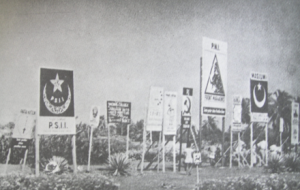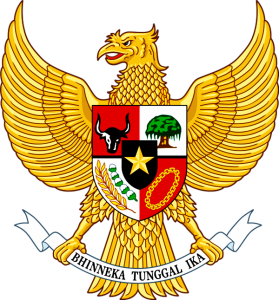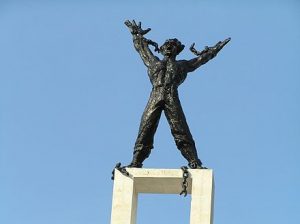Sukarno's Presidency
Democratic Experiment

With the unifying struggle to secure Indonesia’s independence over, divisions in Indonesian society began to appear. These included regional differences in customs, religion, the impact of Christianity and Marxism, and fears of Javanese political domination. Following colonial rule, Japanese occupation, and war against the Dutch, the new country suffered from severe poverty, a ruinous economy, low educational and skills levels, and authoritarian traditions. Challenges to the authority of the Republic included the militant Darul Islam who waged a guerrilla struggle against the Republic from 1948 to 1962; the declaration of an independent Republic of South Maluku by Ambonese formerly of the Royal Dutch Indies Army; and rebellions in Sumatra and Sulawesi between 1955 and 1961.
In contrast to the 1945 Constitution, the 1950 constitution mandated a parliamentary system of government, an executive responsible to parliament, and stipulated at length constitutional guarantees for human rights, drawing heavily on the 1948 United Nations Universal Declaration of Human Rights. A proliferation of political parties dealing for shares of cabinet seats resulted in a rapid turnover of coalition governments including 17 cabinets between 1945 and 1958. The long-postponed parliamentary elections were held in 1955; although the Indonesian National Party (PNI)—considered Sukarno’s party—topped the poll, and the Communist Party of Indonesia (PKI) received strong support, no party garnered more than a quarter of the votes, which resulted in short-lived coalitions.
Guided Democracy

By 1956, Sukarno was openly criticising parliamentary democracy, stating that it was “based upon inherent conflict” which ran counter to Indonesian notions of harmony as being the natural state of human relationships. Instead, he sought a system based on the traditional village system of discussion and consensus, under the guidance of village elders. He proposed a threefold blend of nasionalisme (‘nationalism’), agama (‘religion’), and komunisme (‘communism’) into a co-operative ‘Nas-A-Kom’ government. This was intended to appease the three main factions in Indonesian politics — the army, Islamic groups, and the communists. With the support of the military, he proclaimed in February 1957 a system of ‘Guided Democracy’, and proposed a cabinet representing all the political parties of importance (including the PKI). The US tried and failed to secretly overthrow the President, even though Secretary of State Dulles declared before Congress that “we are not interested in the internal affairs of this country.”
Sukarno abrogated the 1950 Constitution on 9 July 1959 by a decree dissolving the Constitutional Assembly and restoring the 1945 Constitution. The elected parliament was replaced by one appointed by, and subject to the will of, the President. Another non-elected body, the Supreme Advisory Council, was the main policy development body, while the National Front was set up in September 1960 and presided over by the president to “mobilise the revolutionary forces of the people”. Western-style parliamentary democracy was thus finished in Indonesia until the 1999 elections of the Reformasi era.
Sukarno's revolution and nationalism

Charismatic Sukarno spoke as a romantic revolutionary, and under his increasingly authoritarian rule, Indonesia moved on a course of stormy nationalism. Sukarno was popularly referred to as bang (“older brother”), and he painted himself as a man of the people carrying the aspirations of Indonesia and one who dared take on the West. He instigated a number of large, ideologically driven infrastructure projects and monuments celebrating Indonesia’s identity, which were criticised as substitutes for real development in a deteriorating economy.
Western New Guinea had been part of the Dutch East Indies, and Indonesian nationalists had thus claimed it on this basis. Indonesia was able to instigate a diplomatic and military confrontation with the Dutch over the territory following an Indonesian-Soviet arms agreement in 1960. It was, however, United States pressure on the Netherlands that led to an Indonesian takeover in 1963. Also in 1963, Indonesia commenced Konfrontasi with the new state of Malaysia. The northern states of Borneo, formerly British Sarawak and Sabah, had wavered in joining Malaysia, whilst Indonesia saw itself as the rightful ruler of Austronesian peoples and supported an unsuccessful revolution attempt in Brunei. Reviving the glories of the Indonesian National Revolution, Sukarno increased the anti-British sentiment in his rhetoric and mounted military offensives along the Indonesia-Malaysia border in Borneo. As the PKI rallied in Jakarta streets in support, the West became increasingly alarmed at Indonesian foreign policy and the United States withdrew its aid to Indonesia.
In social policy, Sukarno’s time in office witnessed substantial reforms in health and education, together with the passage of various pro-labour measures. However, Indonesia’s economic position deteriorated under Sukarno; by the mid-1960s, the cash-strapped government had to scrap critical public sector subsidies, inflation was at 1,000%, export revenues were shrinking, infrastructure crumbling, and factories were operating at minimal capacity with negligible investment. Severe poverty and hunger were widespread.
